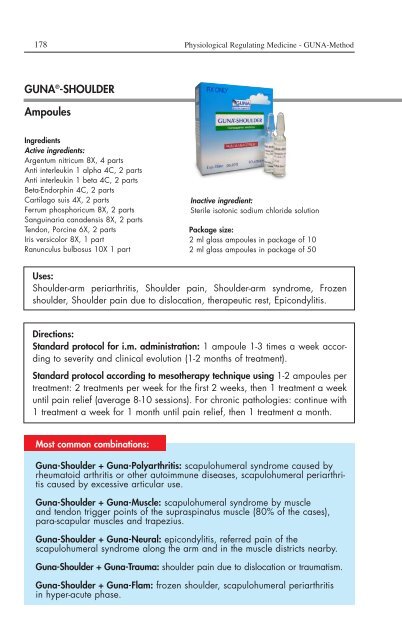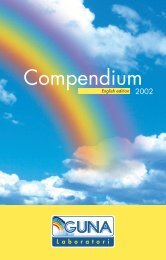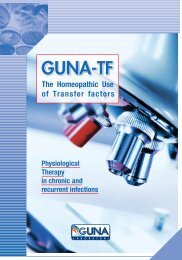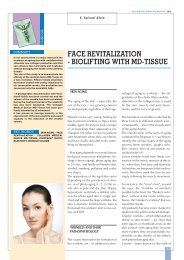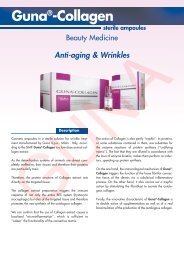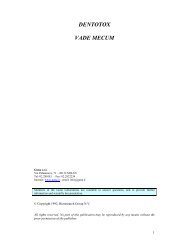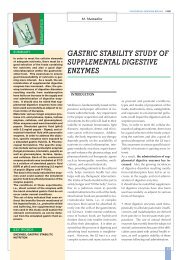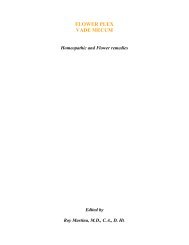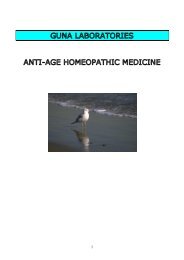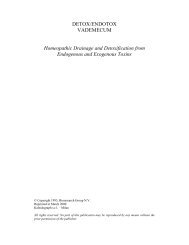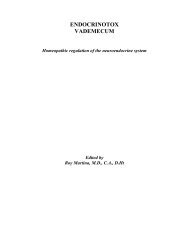Download the Guna Therapeutic Guide - Cyto-Solutions Ltd
Download the Guna Therapeutic Guide - Cyto-Solutions Ltd
Download the Guna Therapeutic Guide - Cyto-Solutions Ltd
Create successful ePaper yourself
Turn your PDF publications into a flip-book with our unique Google optimized e-Paper software.
178<br />
GUNA ® -SHOULDER<br />
Ampoules<br />
Ingredients<br />
Active ingredients:<br />
Argentum nitricum 8X, 4 parts<br />
Anti interleukin 1 alpha 4C, 2 parts<br />
Anti interleukin 1 beta 4C, 2 parts<br />
Beta-Endorphin 4C, 2 parts<br />
Cartilago suis 4X, 2 parts<br />
Ferrum phosphoricum 8X, 2 parts<br />
Sanguinaria canadensis 8X, 2 parts<br />
Tendon, Porcine 6X, 2 parts<br />
Iris versicolor 8X, 1 part<br />
Ranunculus bulbosus 10X 1 part<br />
Most common combinations:<br />
Physiological Regulating Medicine - GUNA-Method<br />
Inactive ingredient:<br />
Sterile isotonic sodium chloride solution<br />
Package size:<br />
2 ml glass ampoules in package of 10<br />
2 ml glass ampoules in package of 50<br />
Uses:<br />
Shoulder-arm periarthritis, Shoulder pain, Shoulder-arm syndrome, Frozen<br />
shoulder, Shoulder pain due to dislocation, <strong>the</strong>rapeutic rest, Epicondylitis.<br />
Directions:<br />
Standard protocol for i.m. administration: 1 ampoule 1-3 times a week according<br />
to severity and clinical evolution (1-2 months of treatment).<br />
Standard protocol according to meso<strong>the</strong>rapy technique using 1-2 ampoules per<br />
treatment: 2 treatments per week for <strong>the</strong> first 2 weeks, <strong>the</strong>n 1 treatment a week<br />
until pain relief (average 8-10 sessions). For chronic pathologies: continue with<br />
1 treatment a week for 1 month until pain relief, <strong>the</strong>n 1 treatment a month.<br />
<strong>Guna</strong>-Shoulder + <strong>Guna</strong>-Polyarthritis: scapulohumeral syndrome caused by<br />
rheumatoid arthritis or o<strong>the</strong>r autoimmune diseases, scapulohumeral periarthritis<br />
caused by excessive articular use.<br />
<strong>Guna</strong>-Shoulder + <strong>Guna</strong>-Muscle: scapulohumeral syndrome by muscle<br />
and tendon trigger points of <strong>the</strong> supraspinatus muscle (80% of <strong>the</strong> cases),<br />
para-scapular muscles and trapezius.<br />
<strong>Guna</strong>-Shoulder + <strong>Guna</strong>-Neural: epicondylitis, referred pain of <strong>the</strong><br />
scapulohumeral syndrome along <strong>the</strong> arm and in <strong>the</strong> muscle districts nearby.<br />
<strong>Guna</strong>-Shoulder + <strong>Guna</strong>-Trauma: shoulder pain due to dislocation or traumatism.<br />
<strong>Guna</strong>-Shoulder + <strong>Guna</strong>-Flam: frozen shoulder, scapulohumeral periarthritis<br />
in hyper-acute phase.


